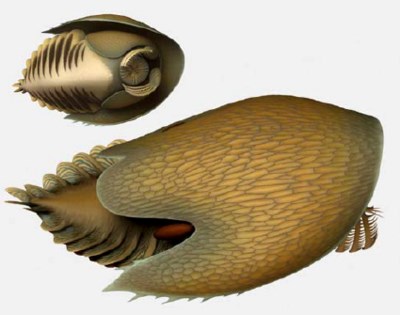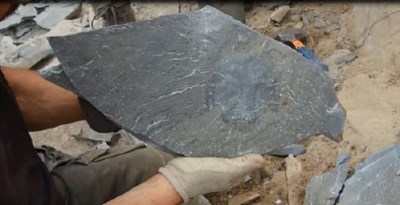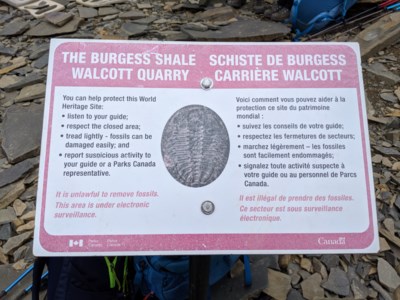For many, one of the best parts about living in the mountains is the ability to hike any of the peaks we see before us, maybe never knowing some of them hold more than we can imagine – like the soft embedded shapes of little creatures who lived here long before we did.
Scientists at the Royal Ontario Museum (ROM) have been studying species found in these mountains on what’s known as the Burgess Shale since the early 1900s and are still discovering new species – in fact, one has just recently been announced.
“A voracious Cambrian predator, Cambroraster,” reads the first line of press release announcing the addition, which looks like a flat space shipshaped fish with rake-like claws. Its full scientific name is Cambroraster falcatus.
 Reconstruction illustration of Cambroraster falcatus ROM PHOTO
Reconstruction illustration of Cambroraster falcatus ROM PHOTO
The species would have lived 508 million years ago during what is known as the Cambrian period. What is now the Canadian Rockies was then a vast ocean with many creatures living within it – the world’s first complex marine ecosystem, according to the ROM's website. The Richard M. Ivey curator of invertebrate paleontology at the ROM and leader of the field expeditions unearthing this new fossil, Jean-Bernard Caron said the discovery of the new species is exciting because of its predatory ways.
“It’s bigger than my hand when most of the animals at that time were the size of my thumb, or thumbnail to be more exact,” said Caron from his desk at the ROM in Toronto during a phone interview with the Outlook.
“Why is it exciting? It shows an entirely new group of predators, basically focusing on predation at the sea bottom. We knew top predators lived at the time … lived in the water column and were able to swim around. This guy that we found from the Kootenay’s seems to be very poor at swimming and they seemed to be more adapted to predate or chase smaller preys at the bottom.”
Cambroraster falcatus specimens were first found in 2012, according to Caron, but only pieces and until last year, they didn’t have enough to really study the water-dwelling creature.
“We found a lot of specimens last summer, but actually the first specimen we found was in 2012, but we didn’t actually know that,” said Caron.
“When we found the Marble Canyon site in Kootenay National Park in 2012, we collected a lot of specimens but it’s only after several explorations in ’14, 2016, that we found additional pieces but not really enough material to really study this animal.”
Leading the study of the bottom-feeding creature was graduate student Joe Moysiuk. As part of his PhD research in ecology and evolutionary biology at the University of Toronto, Moysiuk has been working with Caron as his supervisor.
“Cambroraster was a distant cousin of the iconic Anomalocaris, the top predator living in the seas of that time, but it seems to have been feeding in a radically different way,” he said in a press release from the ROM.
 Moment of exposing fossilized carapace of Cambroraraster falcatus during quarry fieldwork. ROM PHOTO.
Moment of exposing fossilized carapace of Cambroraraster falcatus during quarry fieldwork. ROM PHOTO. In terms of the creature's name, well, Moysiuk and Caron had a bit of fun with that.
“We found a lot of specimens of this new animal that we call Cambroraster falcatus ... cambrorastor means the rake of the Cambrian in reference to the appendages of this strange creature, which we think was able to rake the surface of the mud and collect anything that was living there,” explained Caron.
“And falcatus basically means falcon in the shape of the falcon … also in reference to the Millennium Falcon from Star Wars which we thought because it’s so intriguing in shape. Of course it’s not a space ship.”
Currently, there are a few fossil yielding sites in the Canadian Rockies; Marble Canyon in Kootenay National Park in British Columbia discovered in 2012 and where the newest species was found, the Walcott Quarry in Yoho National Park discovered in 1909 by Charles Walcott, the first paleontologist to discover the fossil-yielding site, and the Mount Stephen trilobite beds, also discovered by Walcott.
If you’re living in or visiting the Rockies, you can even participate in a guided hike of the mountains that were once part of an escarpment to two of the fossil-yielding sites, the Walcott Quarry and the trilobite beds on Mount Stephen.
Here at the Outlook, we were able to hike to the Walcott Quarry, a guided interactive hike through Parks Canada, to find some fossils for ourselves. It was wonderful timing as well because the ROM had just released the research paper about Cambroraster falcatus.
 A Walcott Quarry sign alerts you to the delicate nature of the area you're standing in. ALANA MACLEOD RMO PHOTO
A Walcott Quarry sign alerts you to the delicate nature of the area you're standing in. ALANA MACLEOD RMO PHOTOThe hike to the Walcott Quarry is 22 kilometres there and back with an elevation gain of 825 metres. Guided by Burgess Shale Hike coordinator, Ardelle Hynes, the hike itself was breathtaking, revealing stunning views of Emerald Lake and surrounding mountaintops with Hynes adding in her own colourful additions.
“There’s a couple of versions of how Walcott found the very first fossil,” Hynes said during a stop around 2.5-km into the hike.
“In the one version, he is horseback riding with his wife and his wife’s horse kicks over a slab and on it he spots a fossil ... So the horse kicks over this rock, he spots it, but it's late August, there’s a snowstorm in the offing, and they had to clear out … The other version is that he was kind of suspicious there might be fossils up here and on the trail there was a slab with a fossil on it. He identified it, dug for a further week, and he kept coming for the next 20 years, actually.”
We were a small group of six and when we reached the quarry, the hunt was on for fossils. It was easy to find trilobites, one of the earliest-known arthropod groups and also one of the more popular creatures to find on any of the sites. Ironically, Caron said not a single specimen of the new species was found at the Walcott Quarry.
Aside from hunting for fossils, the interactive hike is an entire experience in itself educating its participants on the history of the quarry and the fossils within it. Using images, fossils themselves, and a vast knowledge of the Burgess Shale, Hynes truly made the full 11-hour day one to be remembered.
If you’re interested in hiking to the Burgess Shale site, it’s important to note that the area is closed off to hikers unless they are on a guided hike. Taking any specimens from any sites could lead to up to a $25,000 fine and a guaranteed court date. Anyone interested in hiking should visit either Parks Canada’s website or the Burgess Shale Geoscience Foundation at www.burgess-shale.bc.ca.



